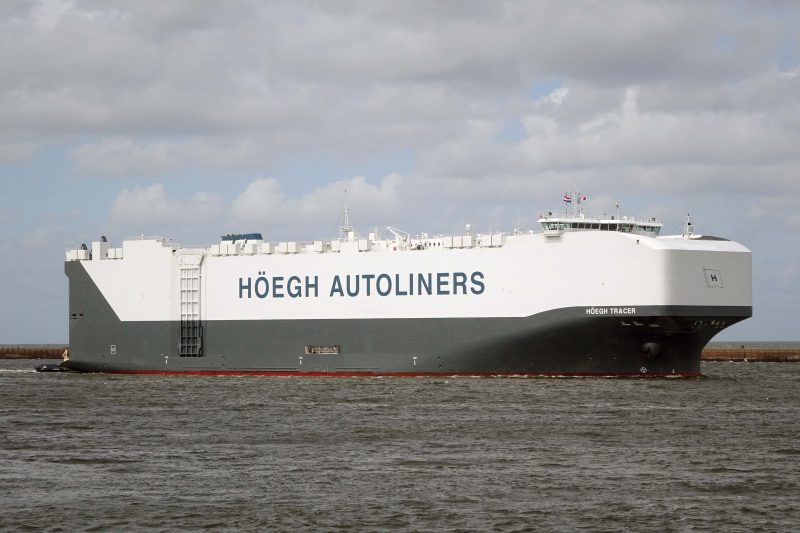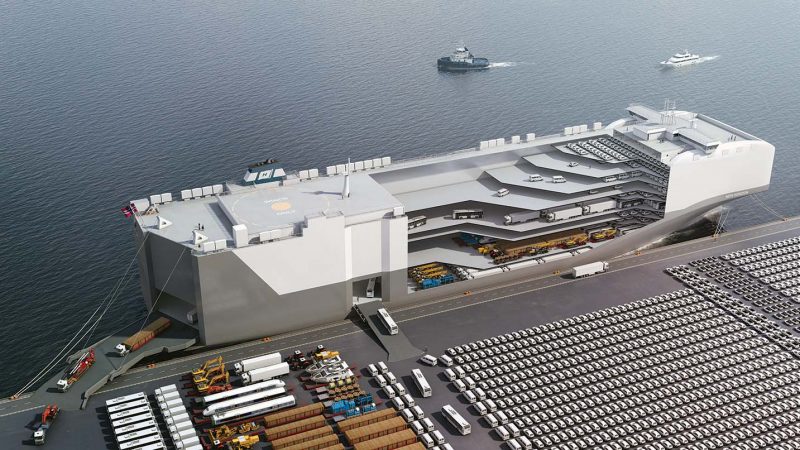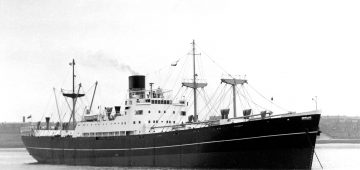Vehicle carriers ply their trades around the globe whilst, with a few exceptions, failing to win prizes for their aesthetics. However, the trademark “floating box” appearance allows the ship to carry the maximum cargo within its footprint so that every square metre of deck space can earn its keep.
The first cargo ships specially fitted for the transport of large quantities of cars came into service in the 1960s and in 1973 the European Highway, built for Japan’s K Line, became the first pure car carrier (PCC), which carried 4,200 vehicles. Today’s pure car carriers and their derivative, the pure car/truck carrier (PCTC), are plentiful with many examples to be seen around UK waters. This shipping sector has been thrust into the limelight twice in recent times following the loss of stability incidents involving the 51,770gt/2000 built Höegh Osaka and the 33,831gt/2001 built Modern Express. Despite the alarming degree of list on both ships, they survived their ordeals and were successfully salvaged. Versatility demanded the introduction of the PCTC with hoistable vehicle decks to increase clear heights, as well as more resilient decks for trucks, construction machinery, project cargoes etc. As demand for shipments has grown, so have the ships built for this trade with the 8,000 CEU (car equivalent units) threshold being arrived at in 2007 when the 71,583gt Faust was delivered. The ships kept on growing with the 75,251gt Tønsberg arriving in 2011 and further ground breakers followed in her wake such as Höegh Autoliner’s 8,500 CEU/76,420gt New Horizon class that took to the water in 2015.
A History to Trace
Höegh’s ship owning history goes back to 1927 and since then the Company has been a pioneer in the international shipping industry. In 1927, Mr Leif Høegh founded Leif Höegh & Co. and since then Höegh has been a well-recognised name in the international shipping industry. The owning and operation of oil tankers came to form the mainstay of Leif Höegh & Co. from the early days. However, from a process of transition in the 1960s, the company diversified into new activities, introducing new concepts for transportation. Having operated combined oil/bulk/ore carriers (OBO), the company gravitated towards the transportation of cars using lift on/lift off vessels. In 1970, a joint venture was formed with Ugland which shaped Höegh-Ugland Auto Liners (HUAL). This company became the basis for developing Höegh into a world leading Ro-Ro operator. In December 1987, Leif Höegh & Co. ASA was listed on the Oslo Stock Exchange after merging the various ship owning entities. This consolidation process laid the basis for new development towards a decentralised business model.
In 1995, Höegh Fleet Services A/S was established as a separate ship management entity, serving Leif Höegh’s fleet and in March 2000, Leif Höegh & Co. acquired the other 50% of HUAL. Five years later the operation was renamed Höegh Autoliners. In 2003, the third generation took control of the company. Cousins Leif O. Høegh and Morten W. Høegh made an offer to acquire all outstanding shares in Leif Höegh & Co. A/S. The offer was well received and the company was privatised and de-listed. In 2006, the company was restructured into two separate entities, namely Höegh Autoliners and Höegh LNG, with a common holding company known as Leif Höegh & Co. Limited. The ship management expertise is maintained in Höegh Fleet Services. In 2008, Höegh Autoliners relocated its ship owning activities from Bermuda to Norway. The same year the company acquired a fleet of 12 car carriers from A.P. Moller Maersk (APMM) and APMM became a minority shareholder holding 37.5% of the shares in Höegh Autoliners (HA). A year later APMM used the option to purchase another 1.25% of HA and that corporate structure is maintained in the present day. At the time of writing, HA listed an operational fleet of 53 ships in spring 2016. The vessels serve 15 deep sea trade routes in a global trade system, shipping cars, sports utility vehicles (SUVs), high and heavy and breakbulk cargoes plus trucks, buses and trailers. The short sea trades operate via a 50/50 joint venture with Mitsui OSK Lines, resulting in the third largest PCTC operator in Europe utilising 15 vessels ranging from 800 CEU to 4,900 CEU in capacity. Höegh also operates Sinor Lines via a joint venture with CSC Ro-Ro Logistics, employing two vessels operating in South East Asia plus a short sea Caribbean feeder service for deep sea trades from Europe and East Asia, based at a hub in Kingston, Jamaica. The company also owns and part owns various vehicle terminals such as Newcastle upon Tyne and Freeport, Texas.
New Horizons
On 18th January 2013 Höegh Autoliners placed an order with Xiamen Shipbuilding Industry for three next generation PCTCs with the option for three more. The state-of-the-art vessels were of the Post-Panamax type, with a carrying capacity of 8,500 cars for delivery as from 2015. The Chinese yard of C&D Xiamen Shipbuilding Industries is the yard with the most experience in the construction of car carriers and previously delivered four PCTCs to Höegh Autoliners, in 2010 & 2011. The new generation of PCTCs became known as the New Horizon class, a design developed by Deltamarin in close co-operation with Höegh Autoliners. The design was also shortlisted as one of the four nominees for the Nor-Shipping Energy Efficiency Award in 2015 plus one of three vessels shortlisted in the Ship of the Year category of the European Marine Engineering awards. The key areas for enhancements were operational performance, safety, energy efficiency and environmental impact. a lot of attention was also paid to optimising the hull form in order to combine high cargo capacity and low fuel oil consumption. The vessel emits only half of the Co2 per transported unit compared to a conventional car carrier. an extensive series of model tests and re-design were undertaken to achieve outstanding performance. in addition to calm water performance, special attention was paid to added resistance in heavy seas and wind resistance. The ship is ergonomically designed with an aerodynamically shaped bow section featuring an enhanced ventilation fan system for easy maintenance and reduced wind-resistance. The class offers 15% more cargo carrying capacity than other ships with similar dimensions and the safety equipment aboard includes a safe access system and enclosed bridge wings. Energy efficiency principles have been followed throughout the ship system design, specifications and selection of equipment considering latest technology in the market. With an attained EEDI (Energy Efficiency design index) of 39% below the IMO reference line, the New Horizon class PCTC is compliant with Phase 3 of the EEDI regulations and has been given DNV-GL’s class notification ‘CLEAN’ for its design. DNV GL is an international certification body and classification society. The ship design features a double-hull construction to reduce pollution from fuel tanks and is fitted with an E-engine for reduced Nox and Sox emissions. additional features include a ballast water system and an oily water treatment system. Steel cutting for the first member of the New Horizon class took place in October 2013 at the C&D Xiamen Shipyard, a facility 100% controlled by Xiamen C&D inc. The shipbuilding business was established in the late 1990s when C&D’s office in Germany was successfully used to attract Swedish companies to place newbuilding orders at the Chinese shipyard with a generous bridging financing package from the C&D group, the parent company of C&D Shipbuilding. in 2002, together with Fujian Shipbuilding Corporation group, C&D jointly sponsored the establishment of Xiamen Shipbuilding, now a leading player for the construction of car carriers, container vessels and bulk carriers. The first newbuild had the name Höegh Target bestowed upon her with the keel laying taking place on 30th April 2014. She was launched on 20th December 2014, named by Mette Folden, wife of Ingar Skiaker, CEO of Höegh Autoliners, on 17th June and delivered on 2nd July 2015. The second sister ship, the Höegh Trigger, was named on 9th September 2015 at a ceremony at Xiamen Shipbuilding industries by Mrs Dorte Wedell- Wedellsborg, wife of Ditlev Wedell-Wedellsborg (director of Höegh Autoliners Holdings AS). The ship was delivered on 17th November 2015.
Target Trio
The first trio of the New Horizon ships was completed when the Höegh Tracer was delivered on 3rd March to Oslo-listed ocean Yield ASA (which currently has 27 ships on its books) and commenced a 12 year bareboat charter to Höegh Autoliners. The ship had been christened on 29th January 2016 at a naming ceremony at Xiamen Shipbuilding industries in China by Hiromi Oe, wife of Akio Oe, President of Nissan Motor Car Carrier (NMCC). The ship assumes the name previously carried by the 33,236gt/1981 built car carrier. The Höegh Tracer’s first port of call was Kanda on 11th March followed by Kobe before reaching Rotterdam on 27th April. like her two sisters, the 76,420gt Höegh Tracer is 199.90m long, has a beam of 36.50m, a draught of 10.31m and a hull depth of 14.40m. The deadweight is 22,068 and the net tonnage is 23,242. To accommodate the 8,500 CEU the Höegh Tracer has a vehicle deck space of 71,400m2, the equivalent of 10 football fields. The ship has 13 full cargo decks, 5 of them hoistable, plus a garage on deck 14. The 5 movable decks can be adjusted to accommodate larger vehicles and other cargoes, thus increasing the vessel’s efficiency. all decks are without protruding lashing fittings. These are now flush with the deck, giving easier and safer access for all kinds of cargo. The access to the vessel is arranged through a 375 tonne stern ramp and a 22 tonne side ramp. The stern ramp entrance has a clear height of 6.50 metres and a width of 12 metres. The vessel provides accommodation for up to 23 crew members (on the upper most deck aft of the bridge) and has a sea endurance of up to 30,000 sea miles and can sail at a maximum speed of 21 knots. The New Horizon sister ships are powered by a single MAN 6S60ME-C engine rated at 11,735kW. This electronically controlled unit is equipped with Nox-monitoring and an online engine performance system. during a sea voyage, the auxiliary engines (3S 5l21/31 & 1P9l21/31 CSSC Marine Power Co., ltd. units) can be turned off so that the most efficiently produced electricity comes from the shaft generator.
MAN diesel & Turbo also signed a deal with XSI to supply Kappel propeller blade designs to the ships. The propellers save up to 6% of fuel compared to conventional propellers. an optimal hull and rudder design, together with use of the latest technology of underwater paint/antifouling, reduces the drag, which in turn also lowers energy consumption. The ship also uses environmentally friendly refrigerants and is prepared for larger diesel and low sulphur fuel oil tanks, as well as having reserved space for future scrubber installation.
TECHNICAL SPECIFICATIONS
IMO: 9684990
Yard No: 462C
Builder: C&D Xiamen Shipbuilding industry Co., ltd.
Shipyard: Xiamen, China
DNV Classification: 345 – vehicle Carrier
Class Notation: 1a1 Car carrier BIS BWM(T) Clean COATPSPC(B) E0 ice(C) MCDK NAUT(OC) TMON
Flag: Norway
Port of Registry: Oslo
Registered Owner: ocean Yield ASA, Oksenøyveien 10, 1366 Lysaker, Norway
Ship Manager: Höegh Autoliners A/SDrammensveien 134, 0277 Oslo, Norway.

Gross Tonnage: 76,420
Deadweight: 22,068
Net Tonnage: 23,242
Air Draught: 46.50m
Length Overall: 199.90m
Length bp: 193.063m
Beam: 36.50m
Beam (Extreme): 40.80m
Draught: 10.318m
Hull Depth: 14.40m
Main Engine 6S60ME-C MAN diesel & Turbo, branch of MAN diesel & Turbo SE, Germany (33-44rpm)
Maximum Speed: 21 knots
Main Generators: 3S 5l21/31 & 1P9l21/31 CSSC Marine Power Co., ltd.
Emergency Generator: 1x QSM11 Cummins Emission Solutions
Auxiliary Boiler: Mission oS-2000 Alfa Laval Aalborg (oil/gas fired – exhaust)
Auxiliary Boiler: Alfa Laval Aalborg
Bow Thruster: TCT-220a, Nakashima Propeller – transverse tunnel thruster
Propeller: Kappel mono-block, supplied by MAN
Vehicle Capacity: 8,500 CEU
Crew: 23
Ballast Capacity: 6,907 m3
Special thanks go to Gabriela Stojicevic & Karin Jahren of Höegh Autoliners for all the invaluable assistance with information. Photo Credit: Höegh Autoliners







Comments
Sorry, comments are closed for this item